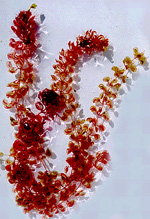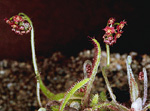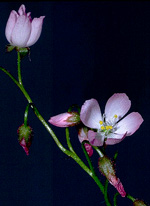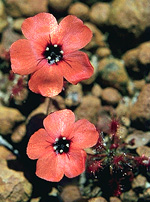 |
This is a small, cosmopolitan family, richest in Australia. The most widespread genus is Drosera, species of which are commonly called sundews and easily recognised by their glistening, insect-trapping hairs. Various species of Drosera are found almost throughout Australia in nitrogen-poor soils, from swampy peats to seasonally moist sandy soils in heathy vegetation, but never in closed forests. The aquatic genus Aldovandra also occurs in Australia but is rarely encountered.
Characteristic features of the family Droseraceae in Australia include: - carnivorous plants with (Drosera) glistening, sticky, gland-tipped hairs that bend over entrapped insects or (Aldovandra) 2-lobed trap-leaves that snap shut on aquatic invertebrates
- flowers small and delicate, in raceme-like cymes (monochasia) that are often coiled (circinate) in bud
- petals 5, free, pink, red or white
- stamens 4 or 5, rarely more
- ovary superior, with several free, feathery styles
Description
Annual, biennial or perennial herbaceous vines, climbing by twining stems, or terrestrial herbs, or aquatic herbs free-floating at or below the water surface. Perennating by tubers or rhizomes. Vegetative reproduction by tubers, rhizomes or by detached stem parts (gemmae). Plants carnivorous, using sticky glands or glandular hairs on the leaves and/or the stems or trap-like irritable leaf-blade segments. Stem internodes terete, oval or slightly flattened. Internal secretions not obvious. Plants glabrous or with simple, clavate, capitate or vesicular glandular, multiseriate hairs. Leaves alternate and spiral, or in whorls of 3–7 or more, cauline, all or mostly basal, or both basal and cauline, petiolate, subsessile or sessile or peltate. Stipules absent or present and intrapetiolar, lacerate or fimbriate, persistent; stipellae absent. Lamina simple or once compound, bifoliolate, symmetric; lamina/lobes filiform, acicular, subulate, linear, lanceolate, ovate, elliptic, oblanceolate, ovate, oblong, spathulate, flabellate, reniform or orbicular; base cuneate, attenuate, rounded or cordate; margins entire or rarely denticulate, ±flat, involute or incurved; venation pinnate, or not obvious, with the midrib conspicuous or inconspicuous, and the tertiary venation not reticulate; surfaces not punctate; herbaceous. Plants with all the flowers bisexual. Inflorescences terminal or axillary, consisting of racemes, panicles, dichasial or monochasial cymes or solitary flowers. Bracts present. Bracteoles present or absent. Pollination by insects. Flowers fragrant; stalked. Floral disc absent; nectaries absent. Free hypanthium absent or obscurely present. Perianth regular, of 2 dissimilar whorls, imbricate in bud. Calyx segments free or fused, with 4–5 (–12) sepals or lobes, herbaceous. Corolla segments free, with 4–5 (–12) petals, alternating with the sepals or calyx lobes, white, cream, yellow, orange, red, pink, magenta, purple, violet, grey, brown or black, without contrasting markings, or streaked, spotted, etc, membranous; claws present or absent; lobes ±entire or notched, emarginate, bifid or bilobed. Fertile stamens (4–) 5 (10–20), opposite to the sepals or calyx lobes, free of the corolla, free of the ovary and style, distinct from each other, all ±equal. Anthers basifixed, not versatile, opening sideways by longitudinal slits, 2-celled. Ovary superior and sessile. Carpels 3–5, fused; ovary with 1 locule. Style terminal, branching from the base. Ovules 3–numerous, stalked; placentation parietal. Fruit a dry, dehiscent loculicidal capsule; the perianth on the maturing fruit dry and persistent. Disseminule micro-surface ±smooth, grey or black, glossy or dull. Seeds 2–numerous per fruit. Aril absent. Cotyledons 2. Embryo straight.
(Note: this description has been generated from the coded data compiled for the key. Any errors in the key data will be reflected in the descriptions.)
A treatment of the family Droseraceae has been published in:
Flora of Australia 8: 9-66.
Australian genera of Droseraceae (as recognised for the Flora of Australia)
Aldrovanda
Drosera

|
  |

Aldrovanda vesiculosa (habit)
Photo: S.Jacobs © S.Jacobs

Drosera adelae (flowering plant)
Photo: M.Fagg © ANBG

Drosera andersoniana (flowers)
Photo: M.Clements © ANBG

Drosera drummondii (flowers)
Photo: F.Humphreys © ANBG

|
 |
|